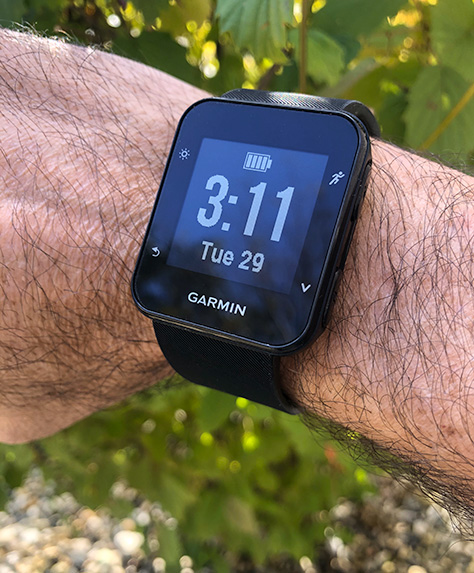Product Review: Garmin Forerunner 35 GPS Watch
Once the FR35 went down to $100 I knew I had to have it. It isn’t that much different from my trusty Forerunner 15, but it has a few features which made it a worthy upgrade.
The watch itself is quite lightweight and has an extremely-comfortable soft, silicone band. The strap is highly adjustable so you can get it just right. It’s also inexpensive and easily replaceable.
The data screens are perfectly amazing. I have 3 data fields I like to view during a race: Pace, Heart Rate, and Cadence. Here’s where things get a little complicated… Pace (current) on the FR35 just isn’t useable-it’s all over the place. The workaround I found is to use Lap Pace instead. This is the game-changer for run pacing.
With imperial settings that means a lap (and new split) every mile. This is now very accurate since it’s a longer running average rather than trying to give instantaneous pace. I think that as long as you run a fairly consistent pace the mile average will be accurate enough for most.
If you are able to use metric units you will get more splits because obviously kilometers are shorter than miles. Every mile I get a little beep and a vibration alert with a new split. But that split is almost unnecessary because I have that average lap pace on my screen so I already have a pretty good idea about what the mile split is going to be. It all just works!
There is a second page for data fields. I find that much less important as I try to focus on the present whether I’m training or racing. And beyond those three fields I already listed-there isn’t much data to use for the present. Nevertheless, my settings for page two of the screen data fields are time (as in race time elapsed), distance (total) and cadence again because you can never have too much cadence!
The battery seems reasonably strong on the FR35 which is to be expected from a modern Garmin. It’s rated to up to 13 hours in GPS mode, but I think if you have a race that goes over 8 hours-you can find a watch with a stronger battery life. I’d think this would be great for up to 70.3 distance in triathlon.
I don’t use Garmin’s Connect app at all. I have the latest firmware in the watch already and I just plug the watch in to charge, scroll to activities and pull the latest .fit file I need to upload on Strava.
Now the drawbacks. It takes a long time to find a GPS satellite on startup. It sucks standing around for 2 or 3 minutes waiting to pick up a sat. signal if it’s not already cached. It really sucks if you’re on the start line and the race starts in a minute or two! The built-in heart rate monitor is a waste of space in my opinion. It’s bulky, inaccurate much of the time and taxes the watch’s resources. Instead, I use an old HRM1G heart rate strap that works very well. I’m sure a better strap will come along in coming years, but I haven’t found one that suits my needs better than the inexpensive, durable HRM1G.
To make the ultimate minimalist running watch that works for triathlon as well here is my quick summary in order. 1) Ditch the optical heart rate monitor for a lighter, less bulky experience. 2) Add Strava CR segments. 3) Faster satellite lock on startup. 4) General GPS performance upgrade. Because sometimes the mile splits are off. I almost feel like my old FR15 had cleaner GPS data. 5) Fix the unusable Pace data field. Instead of displaying instantaneous pace (which is what I imagine it does now) use a 5-20 second average that smoothes out the data.

